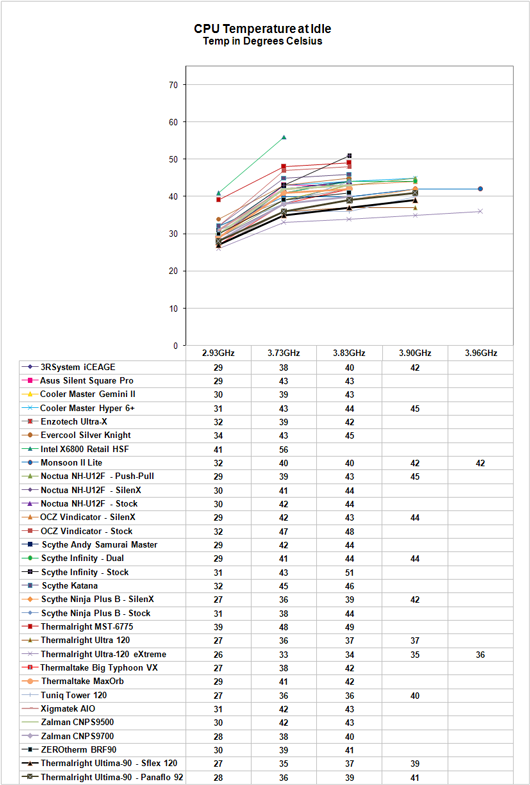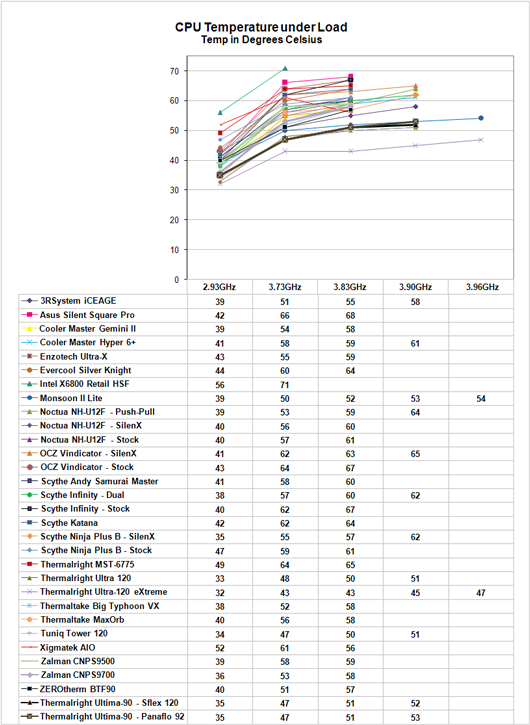Thermalright Ultima-90: Small Wonder?
by Wesley Fink on August 20, 2007 2:00 AM EST- Posted in
- Cases/Cooling/PSUs
Scaling of Cooling Performance
The Ultima-90 performance was top-of-the-line at both stock idle and stock load compared to other top air coolers tested at AnandTech. Excellent performance at stock speeds is one thing, but we were interested in seeing how this smaller, lighter Thermalright scales in cooling higher overclocks. The Ultima-90, to put it short and sweet, is a fierce competitor at higher speeds.
At 2.93GHz the retail HSF is running at 41C, compared to 27C with the Ultima-90/120. This is a delta of 14C. The delta generally becomes greater with the better heatsinks as the overclock increases. At 3.73GHz idle the retail HSF is 56C compared to the Ultima-90 at 35C - a delta of 21C. The cooling performance of the Ultima-90 is significantly better than the Intel retail cooler at idle. The Thermalright Ultima-90 also closely mirrors the best air performance ever measured with this X6800 CPU.
Looking closely at the curves of the top coolers tested, the Ultima-90 is almost a shadow curve for the Tuniq 120 and the Thermalright Ultra-120. This is true with either the 92mm or 120mm test fan. At the very top the 120mm fan squeezes out a bit higher overclock, but the results are otherwise identical. Considering the Ultima-90 is smaller, lighter, and cheaper than the coolers it matches in performance, the Ultima-90 a very attractive choice.
We also need to compare cooling efficiency of the Ultima-90 under load conditions to the retail HSF and other recently tested CPU coolers. Load testing can be very revealing of a cooler's efficiency. A basically flat line, particularly form 3.73GHz upward, indicates the cooler is still in its best cooling range. A line that is increasing rapidly indicates a cooler nearing the end of its ability to cool efficiently. Lines which parallel the best coolers over a range of values are indicate that the coolers have similar cooling efficiency.
The Ultima-90 is very efficient in cooling in the 2.93 GHz to 3.83 GHz overclock range. It then continues on to a highest overclock of 3.90GHz with the 120mm Scythe S-FLEX fan or 3.870GHz with the 92mm Panaflo. The Ultima-90 matches the top coolers tested in performance. The only air cooler that outperforms the Ultima-90 is the Thermalright Ultra-120 eXtreme, which is larger, heavier, and more expensive. We expected good performance and cooling at high overclocks with the Ultima-90, particularly after discussing the design philosophy with Thermalright. However, we did not really expect performance so close to their flagship eXtreme.
As stated many times, the overclocking abilities of CPUs will vary at the top, depending on the CPU. This particular CPU does higher FSB speeds than any X6800 we have tested, but the 3.90GHz top speed with the Tuniq is pretty average among the X6800 processors we have tested with Tuniq cooling. A few of the other processors tested with the best air coolers reach just over 4 GHz, but the range has been 3.8 to 4.0GHz. Stock cooling generally tops out 200 to 400 MHz lower, depending on the CPU, on the processors tested in our lab.
The Ultima-90 performance was top-of-the-line at both stock idle and stock load compared to other top air coolers tested at AnandTech. Excellent performance at stock speeds is one thing, but we were interested in seeing how this smaller, lighter Thermalright scales in cooling higher overclocks. The Ultima-90, to put it short and sweet, is a fierce competitor at higher speeds.
 |
| Click to enlarge |
At 2.93GHz the retail HSF is running at 41C, compared to 27C with the Ultima-90/120. This is a delta of 14C. The delta generally becomes greater with the better heatsinks as the overclock increases. At 3.73GHz idle the retail HSF is 56C compared to the Ultima-90 at 35C - a delta of 21C. The cooling performance of the Ultima-90 is significantly better than the Intel retail cooler at idle. The Thermalright Ultima-90 also closely mirrors the best air performance ever measured with this X6800 CPU.
Looking closely at the curves of the top coolers tested, the Ultima-90 is almost a shadow curve for the Tuniq 120 and the Thermalright Ultra-120. This is true with either the 92mm or 120mm test fan. At the very top the 120mm fan squeezes out a bit higher overclock, but the results are otherwise identical. Considering the Ultima-90 is smaller, lighter, and cheaper than the coolers it matches in performance, the Ultima-90 a very attractive choice.
We also need to compare cooling efficiency of the Ultima-90 under load conditions to the retail HSF and other recently tested CPU coolers. Load testing can be very revealing of a cooler's efficiency. A basically flat line, particularly form 3.73GHz upward, indicates the cooler is still in its best cooling range. A line that is increasing rapidly indicates a cooler nearing the end of its ability to cool efficiently. Lines which parallel the best coolers over a range of values are indicate that the coolers have similar cooling efficiency.
 |
| Click to enlarge |
The Ultima-90 is very efficient in cooling in the 2.93 GHz to 3.83 GHz overclock range. It then continues on to a highest overclock of 3.90GHz with the 120mm Scythe S-FLEX fan or 3.870GHz with the 92mm Panaflo. The Ultima-90 matches the top coolers tested in performance. The only air cooler that outperforms the Ultima-90 is the Thermalright Ultra-120 eXtreme, which is larger, heavier, and more expensive. We expected good performance and cooling at high overclocks with the Ultima-90, particularly after discussing the design philosophy with Thermalright. However, we did not really expect performance so close to their flagship eXtreme.
As stated many times, the overclocking abilities of CPUs will vary at the top, depending on the CPU. This particular CPU does higher FSB speeds than any X6800 we have tested, but the 3.90GHz top speed with the Tuniq is pretty average among the X6800 processors we have tested with Tuniq cooling. A few of the other processors tested with the best air coolers reach just over 4 GHz, but the range has been 3.8 to 4.0GHz. Stock cooling generally tops out 200 to 400 MHz lower, depending on the CPU, on the processors tested in our lab.










38 Comments
View All Comments
andereandre - Tuesday, August 21, 2007 - link
In these articles the Intel HSF is always classified as having the same noise level as the best coolers (and system-ps & no fans).
I have a X2 4600 however, and I hear the AM2 stock cooler at idle.
Does this mean that de Intel stock cooler is that much better than the AMD one, or is it just the measurement?
That is of real interest to me as I am looking to replace my cooler to make my pc more silent, not to oc it.
Wesley Fink - Tuesday, August 21, 2007 - link
Early Intel 775 stock coolers were very noisy, but for the last year or so the Intel stock cooler is very quiet. That is further enhanced by the 4-pin fan connection that varies fan speed based on CPU temp and BIOS settings. Intel also uses a fan that is a standard 25mm thick.While I don't have measurements for you, the AMD fan is noisier to my ears. AMD does use heatpipes, but they also use a very thin fan that has to run higher rpm to move enough air for cooling.
Beenthere - Monday, August 20, 2007 - link
For years Thermalright has delivered best in class performance with all of the products. No reason to expect any difference with the Small Wonder. Thermalright does good engineering and proves out their product instead of rushing some POS out the door as the trick-of-the week product. And with Thermalright you don't get some stupid shitze whisles and bells to sucker the clueless sheep into buying their products.Axbattler - Monday, August 20, 2007 - link
@ Wesley Fink: Can you please confirm that the height of the cooler with a 120mm fan attached is indeed shorter than the Ninja with a 120mm fan attached? I know that the Ninja is 150mm high, whereas the Ultima is 139mm, so I would expect, all things being equal that the Ultima requires less space than the Ninja. But a confirmation would be helpful as I've been looking for a cooler with comparable performance with the Ninja but a few (5-10mm) shorter.Wesley Fink - Monday, August 20, 2007 - link
1600 RPM is correct, and the chart is corrected.As for the Scythe Infinity, we can only report what we find, and others report what they find. You might compare test beds and methods for an explanation. The Infinity is deservedly loved by those whose primary goal is silence. That means the fan is relatively low output compared to coolers designed for overclocking as the primary goal.
We did find the Infinity reached 3.90 GHz at the top tier of our performance results when two fans were used in a push-pull arrangement. That is also included in our Scaling charts. As reported in our Infinity review the cooler can mount up to four fans.
jackylman - Monday, August 20, 2007 - link
In the first sentence of the last paragraph on the last page."We asked in the beginning of this review if the smaller and lighter Thermalright Ultima-120 might be too compromised...
Wesley Fink - Monday, August 20, 2007 - link
We saved the most obvious for last :) Now corrected.xxxCHAOSxxx - Monday, August 20, 2007 - link
Gents,I have been looking at the cooler market for about 2 or 3 months.. I was torn between the Tuniq 120, thermalright Ultra 120 and the Vigor Monsoon.. however each had a few things that i am a bit leary of. Mainly the weight and size issue. Currently I am running a thermaltake typhoon but am not happy with it. I have to go in every so often and adjust the screws holding it down as they appear to lossen over a short period of time. Based on your review of the thermals, i have just ordered the Ultima 90 and will drop you a line based on my results.
thanks!!
E6600
EVGA 680i
2Gig Memory
EVGA 8800GTX KO w/ ACS3
Thermaltake Armor
Thermaltake Toughpower 800
yacoub - Monday, August 20, 2007 - link
Been looking forward to an Anandtech review of this cooler for about three months now (since the first sneak peak review was seen on another forum). Glad to see this is indeed a pretty badass cooler! =)MercenaryForHire - Monday, August 20, 2007 - link
Something's not quite adding up there ...